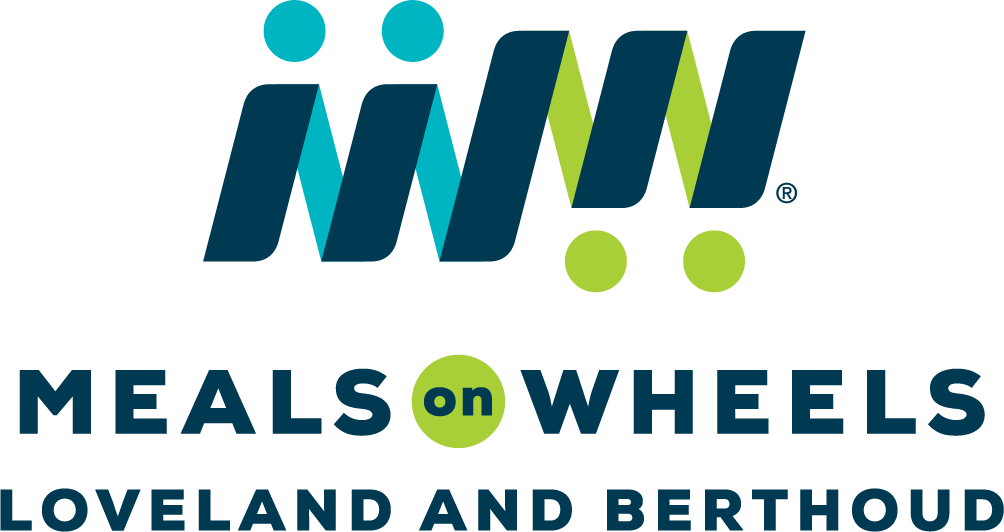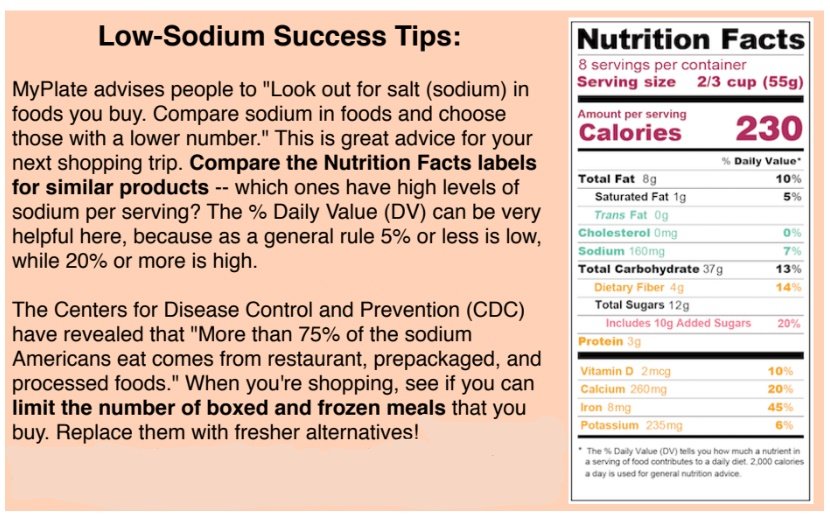THE SCOOP: Keep it Low: Making Low-Sodium Choices for Better Health
Why Go Low Sodium?
Eating too much sodium (salt) can raise your risk of high blood pressure, heart attack, and stroke. The good news is that cutting down on sodium can help lower your blood pressure and keep your heart healthy.
We only need a small amount of sodium to stay healthy, but most people get too much. Use other spices and herbs to flavor your food in order to keep a low sodium diet.
A prospective study in Finland found that for each 2,400 mg increase in 24-hour urinary sodium, the rates of cardiovascular disease mortality increased by 36%, and total mortality increased by 22% (Lancet 20091;357.848-51).
Worldwide hypertension (high blood pressure) is the #1 risk factor for earlier mortality in middle-aged and older adults.
Cutting down on sodium is important for heart health and can have a positive impact on blood pressure.
what is sodium?
Sodium is a mineral that’s found in salt. Whenever you add salt to your food, you’re adding sodium. But most of the sodium we eat doesn’t come from our salt shakers! Sodium is in almost all processed and prepared foods we buy, like ready-to-eat meals and restaurant meals.
The Dietary Guidelines for Americans recommend that people consume no more than 2300 mg of sodium every day. People who are age 51 and older, who are of African-American descent, or who have high blood pressure, diabetes, or chronic kidney disease should aim for no more than 1500 mg of sodium per day.
So, how can you go low-sodium?
You don’t have to give up all your favorite foods - just try these tips to cut down on sodium.
Choose fresh, unprocessed foods
Fresh, unprocessed foods typically contain very little sodium. Stock up on seasonal fresh fruits and vegetables!
SKIP ADDED SODIUM
Lots of sodium lurks in canned and frozen foods. Look for varieties with a “No Salt Added” label and be sure to check the Daily Value (DV) for sodium. You can find the DV listed on the Nutrition Facts Label.
think about grains
According to the Centers for Disease Control, 36.9% of the average amount of sodium consumed came from grains, and these include highly processed foods like bread, frozen meals, and soups. Meals on Wheels always cooks with whole grains. You can always look for whole grains that are easy to cook like rice and oatmeal. Break and boxed grain meal mixes can often pack a sodium wallop!
cook more meals at home
Remember, most foods prepared outside of the home are high in sodium, including prepared or packaged foods you buy at the store and foods from restaurants. Cooking your own meals puts you in control! Just remember to choose ingredients that are low in sodium.
You can find tasty, heart-healthy recipes from the MyPlate Kitchen tool: MyPlate.gove/MyPlate-Kitchen
check labels
Meals on Wheels of Loveland and Berthoud monitors and analyzes sodium levels in each meal and recipe. Our menus meet 1/3 of the recommended adult daily dietary intake.
You can monitor your store-bought food and mixes by checking the nutrition information for all of the ingredients. Look at the % of Daily Value (DV):
5% DV or less is a LOW source of sodium
20% DV or more is a HIGH source of sodium
More often, choose foods that are lower in sodium.
try these healthy lower-sodium swaps
Add flavor with herbs and spices instead of salt.
Snack on crunch veggies or unsalted nuts instead of salted chips or pretzels.
Choose fresh chicken and turkey, lean meats, or seafood instead of deli meats or sausages.
Restaurant dining can still be enjoyed by planning ahead for a lower-sodium meal.
look for lower-sodium options when you eat out
At restaurants, ask for nutrition information and choose dishes that are lower in sodium.
Get dressings and sauces on the side- and only use what you need.
Eat a smaller portion or split a meal with a friend.
Remember, small changes make a big difference! Start simple - begin cutting down on sodium today!
Here are some resources to get you started:
Learn about the Dietary Guidelines for Americans and get more resources to help you eat healthy at DietaryGuidelines.gov
Find healthy eating tips and recipes at MyPlate.gov
Learn about the DASH eating plan that can help lower your blood pressure at nhlbi.nih.gov/Health-Topics/DASH-Eating-Plan
Content provided by Food and Health Communications, Inc. & Nutrition and Aging Resource Center



